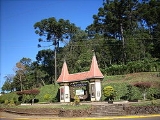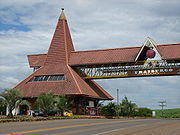
Fraiburgo
Encyclopedia
Fraiburgo is a Brazil
ian city located in the countryside of the Santa Catarina
state. The city is strongly influenced by European immigrants, especially Germans
and Italians. However, other nationalities also contributed to the formation of the city's character in terms of e.g.: architecture, gastronomy, religion and economy, amongst other factors. Its multiculturality is a remarkable characteristic not exclusively attributed to Fraiburgo but many other Southern Brazilian towns.
The city is famous in Brazil
for the large production of apples which its plantation is favored by the low temperatures in the winter season in the Southern Hemisphere
that takes place in July, August and September. Depending on the period of the year tourists can experience first-hand the whole apple production cycle as well other products made from apple such as: cider
, juices, snacks and so forth.

of Fraiburgo's region was based on sawmills . The former dense forests consisted mostly in Brazilian walnuts, Cedar
s, Cinnamon
s, Yerba mate
, and the exuberant Brazilian Pines . These forests still represent the typical Southern Brazilian landscape in spite of ruthless deforestation in the past decades. A significant turnover in the economy took place due to the shortage of wood, implementation of Brazilian environmental laws and environmental consciousness. As a result, agriculture became the predominant source of wealth alongside the production of paper
, cellulose
, and furniture derived from extensive reforestation areas. The reforestation projects introduced the Pinus elliottii to the region.
s are the base of Fraiburgo economy, being responsible for 60% of the total state production and 40% of the national production. The city also produces honey
in large quantities; there are about 15.000 honeycombs to pollinate 7 million apple trees. Moreover, there are familiar farms that produce corn
, beans, garlic
, onion
s, and peach
es.
Brazil
Brazil , officially the Federative Republic of Brazil , is the largest country in South America. It is the world's fifth largest country, both by geographical area and by population with over 192 million people...
ian city located in the countryside of the Santa Catarina
Santa Catarina (state)
Santa Catarina is a state in southern Brazil with one of the highest standards of living in Latin America. Its capital is Florianópolis, which mostly lies on the Santa Catarina Island. Neighbouring states are Rio Grande do Sul to the south and Paraná to the north. It is bounded on the east by...
state. The city is strongly influenced by European immigrants, especially Germans
Germans
The Germans are a Germanic ethnic group native to Central Europe. The English term Germans has referred to the German-speaking population of the Holy Roman Empire since the Late Middle Ages....
and Italians. However, other nationalities also contributed to the formation of the city's character in terms of e.g.: architecture, gastronomy, religion and economy, amongst other factors. Its multiculturality is a remarkable characteristic not exclusively attributed to Fraiburgo but many other Southern Brazilian towns.
The city is famous in Brazil
Brazil
Brazil , officially the Federative Republic of Brazil , is the largest country in South America. It is the world's fifth largest country, both by geographical area and by population with over 192 million people...
for the large production of apples which its plantation is favored by the low temperatures in the winter season in the Southern Hemisphere
Southern Hemisphere
The Southern Hemisphere is the part of Earth that lies south of the equator. The word hemisphere literally means 'half ball' or "half sphere"...
that takes place in July, August and September. Depending on the period of the year tourists can experience first-hand the whole apple production cycle as well other products made from apple such as: cider
Cider
Cider or cyder is a fermented alcoholic beverage made from apple juice. Cider varies in alcohol content from 2% abv to 8.5% abv or more in traditional English ciders. In some regions, such as Germany and America, cider may be termed "apple wine"...
, juices, snacks and so forth.

Economy
In the early stages the economyEconomy
An economy consists of the economic system of a country or other area; the labor, capital and land resources; and the manufacturing, trade, distribution, and consumption of goods and services of that area...
of Fraiburgo's region was based on sawmills . The former dense forests consisted mostly in Brazilian walnuts, Cedar
Cedrela
Cedrela is a genus of seven species in the mahogany family Meliaceae. They are evergreen or dry-season deciduous trees with pinnate leaves, native to the tropical and subtropical New World, from southern Mexico south to northern Argentina. The name is derived from a diminutive form of Cedrus...
s, Cinnamon
Cinnamon
Cinnamon is a spice obtained from the inner bark of several trees from the genus Cinnamomum that is used in both sweet and savoury foods...
s, Yerba mate
Yerba mate
Maté, yerba maté or erva maté , Ilex paraguariensis, is a species of holly native to subtropical South America in northeastern Argentina, Bolivia, southern Brazil, Uruguay and Paraguay...
, and the exuberant Brazilian Pines . These forests still represent the typical Southern Brazilian landscape in spite of ruthless deforestation in the past decades. A significant turnover in the economy took place due to the shortage of wood, implementation of Brazilian environmental laws and environmental consciousness. As a result, agriculture became the predominant source of wealth alongside the production of paper
Paper
Paper is a thin material mainly used for writing upon, printing upon, drawing or for packaging. It is produced by pressing together moist fibers, typically cellulose pulp derived from wood, rags or grasses, and drying them into flexible sheets....
, cellulose
Cellulose
Cellulose is an organic compound with the formula , a polysaccharide consisting of a linear chain of several hundred to over ten thousand β linked D-glucose units....
, and furniture derived from extensive reforestation areas. The reforestation projects introduced the Pinus elliottii to the region.
Agriculture
AppleApple
The apple is the pomaceous fruit of the apple tree, species Malus domestica in the rose family . It is one of the most widely cultivated tree fruits, and the most widely known of the many members of genus Malus that are used by humans. Apple grow on small, deciduous trees that blossom in the spring...
s are the base of Fraiburgo economy, being responsible for 60% of the total state production and 40% of the national production. The city also produces honey
Honey
Honey is a sweet food made by bees using nectar from flowers. The variety produced by honey bees is the one most commonly referred to and is the type of honey collected by beekeepers and consumed by humans...
in large quantities; there are about 15.000 honeycombs to pollinate 7 million apple trees. Moreover, there are familiar farms that produce corn
Maize
Maize known in many English-speaking countries as corn or mielie/mealie, is a grain domesticated by indigenous peoples in Mesoamerica in prehistoric times. The leafy stalk produces ears which contain seeds called kernels. Though technically a grain, maize kernels are used in cooking as a vegetable...
, beans, garlic
Garlic
Allium sativum, commonly known as garlic, is a species in the onion genus, Allium. Its close relatives include the onion, shallot, leek, chive, and rakkyo. Dating back over 6,000 years, garlic is native to central Asia, and has long been a staple in the Mediterranean region, as well as a frequent...
, onion
Onion
The onion , also known as the bulb onion, common onion and garden onion, is the most widely cultivated species of the genus Allium. The genus Allium also contains a number of other species variously referred to as onions and cultivated for food, such as the Japanese bunching onion The onion...
s, and peach
Peach
The peach tree is a deciduous tree growing to tall and 6 in. in diameter, belonging to the subfamily Prunoideae of the family Rosaceae. It bears an edible juicy fruit called a peach...
es.
Climate
Fraiburgo has Seasoned climate: relatively hot dry summers (November to March) with temperatures reaching up to 35 degrees Celsius (95 degrees Fahrenheit) on the hottest days; winters (June to August) cold mornings, typical maximum daily temperatures of 15 degrees Celsius (59 degrees Fahrenheit), and minimums of a few degrees above freezing. The year average temperature 16,1°C (60.8F) Occasional snowfall occurs in suburbs at higher altitudes, and may extend throughout the city, though this happens infrequently (about every 8–10 years).Geography
Its geographical position is 27°01′34"S 50°55′17"W; its height is approximately 1048 meters above sea level. Currently, its population is around 36.170 according to IBGE estimate. However, this figure fluctuates with the guest workers (10.000) throughout the apple harvest season (From January to April).Flag
The municipal flag was instituted by Law nº 303 of 05/09/1977. It was designed by the educators Rui Batagelo and Francisco Costella supported by the professor and vexillologist Antônio Peixoto de Faria. The flag has the colors green, white and yellow. In the center there is the coat of the arms of Fraiburgo (2nd version), representing the municipal government. The green color represents the fields and the harvests. The white color symbolizes the peace, friendship, work, prosperity, pureness, faith. The yellow color represents the industries of the city, generators of wealthCoat of Arms
The coat or arms was created in 1964 in Paris by heraldist Robert Louis on commission of Albert Mahler, an early German-ascent local, and later changed. It refers to Fraiburgo's woods and timber industry (logs and flowers) and St. Catherine's martyrdom tools, for the State's namesake, and includes also storks as supporters standing for Alsatia, whence come the first settlers; cogwheel and apples symbolize Fraiburgo's recent industries.Neighbour Cities
- Lebon RégisLebon RégisLebon Régis is a town and municipality in the state of Santa Catarina in the South region of Brazil.-References:...
- CuritibanosCuritibanosCuritibanos is a city in Santa Catarina, Brazil....
- Frei RogérioFrei RogérioFrei Rogério is a city in Santa Catarina, in the Southern Region of Brazil....
- Monte CarloMonte Carlo (Santa Catarina)Monte Carlo is a city in Santa Catarina, in the Southern Region of Brazil....
- Tangará
- VideiraVideiraVideira is a city in the state of Santa Catarina in Brazil. The estimated population in 2006 was 47,510 inhabitants.The city is called "Capital do Vinho" in reference to the production of this alcoholic drink...
- Rio das AntasRio das AntasRio das Antas is a town and municipality in the state of Santa Catarina in the South region of Brazil.-References:...
- CaçadorCaçadorCaçador is a town and municipality in the state of Santa Catarina in the South region of Brazil.-History:The banks of the Rio do Peixe were inhabited by ethnic native groups of Kaingangs and Xoklengs until 1881, when families of european origin settled here and, because of the abundance of...

